Want pain-free shoulders? Cut down on your Downward dogs and Planks
56A fellow yoga teacher confided in me once: “I had quite a scare in my class yesterday – one of my students had dislocated a shoulder. Luckily, there was a doctor there, who had just popped it right back into place!” Hmm, I thought, I wonder how that happened; and went to his class the following week. I could not lift my arms past my shoulders for three days afterwards. In fact, my shoulders start aching even now at the mere memory of that experience. At the time, I was a fit 20-something year old – what about other older, not-so-fit folks who attended that class?
Unfortunately, in our quest for “power” we sometimes can take it a bit too far and our students’ shoulders suffer as a result. There are several potential issues that can show up and here is why.
Take a look at the structure of the shoulder joint and compare it to the hip joint, both ball-and-socket joints.
As you can see, the socket of the hip joint is much deeper and encloses the head of the femur, which makes it more stable and, as a result, less mobile. You cannot bring your leg up and around, like you can your arm (thank goodness!). In the shoulder joint, on the other hand, it’s not even a socket, it’s more like a shelf, formed by the glenoid cavity on the side and the acromion process on the top. Since the fit is not very tight, the mobility of the shoulder is much greater, which allows us to do all the fun things we want to do with our arms. However, this mobility comes at a price – it makes the shoulder joint less stable and more prone to dislocation and other injuries. Instead of the bony structures, the shoulder joint must be held together by muscles, tendons and ligaments. Their job is to stabilize the joint while allowing for an incredible range of motion.
Another big difference between the two joints is that the hip joint is designed to be a weight-bearing joint, while shoulder isn’t. That means that asking your shoulders to bear weight might be useful for the purpose of muscle strengthening or even improving bone density, BUT it is just not equipped to handle prolonged or repetitive weight bearing activities.
Now let’s take a look at a typical Vinyasa class, that is usually held together by a Sun Salutation sequence which includes all-too-familiar Downward dog – Chaturanga – Upward dog combo.
How many times do you end up doing this sequence within one class? 10? 20? 30? It depends on the teacher. While moving through this sequence, you are asking your shoulder joint to negotiate a delicate dance between flexion, extension, internal and external rotation, all while bearing weight.
What can go wrong?
Have you ever heard of rotator cuff injuries? What it often means is that the tendon of the supraspinatus muscle gets sandwiched between the bones of the shoulder blade and the arm. Supraspinatus is one of four rotator cuff muscles that assists in lifting the arm and stabilizing the shoulder joint.
Supraspinatus impingement usually happens for one of two reasons – mechanical impingement or repetitive microtrauma.
Mechanical impingement happens if you fall down and break the fall with your arm. The head of the humerus will forcefully press into the joint and pinch the tendon(s).
Repetitive microtrauma is an impingement that happens because of the shoulder overuse in the overhead position. It is usually the result of a combination of factors: inherent joint instability, muscular imbalances and repetitive large stresses on the static and dynamic shoulder stabilizers. Let’s say you are someone who has pretty loose shoulder joints (which makes them less stable). You sit at your desk all day typing with your shoulders internally rotated (which over time will cause muscular imbalance). Then at the end of the day you head out to a power yoga class and start loading up your shoulder joints with repetitive Downdogs and Chaturangas. On top of that, you are probably moving fast trying to keep your heart rate up, which makes your shoulders even more vulnerable. Do it enough times and you’ve got yourself some shoulder pain.
On the other hand, if your shoulder joints are not that loose to begin with, you are likely to have difficulty with maintaining proper form as you move in and out of the Downward Dog (which requires external rotation of the shoulders). Repetitive misalignment can also lead to a shoulder injury.
However you look at it, Downward-facing Dog pose is not an easy or “resting “pose, like many students are led to believe. It requires attention to alignment that is hard to achieve when you are moving fast.
Want to put even more stress on your shoulders? Throw in some prolonged weight-bearing moves.
This is an example of another common trend that we see in yoga classes (the one that strained my shoulders all those years ago) – placing too many movements that involve the same joint in a row. We call it cumulative stress. Do you see a problem with this sequence?
Both your shoulders and your wrists are being strained by asking them to bear weight in one pose after another after another without any break in between. As a result, instead of strengthening the muscles, which was probably your original intention, you are stressing and destabilizing your joints.
Cumulative stress is usually a combination of repetitive tasks, mechanical compression and sustained/awkward positions. All of this applies to the sequence above: you are repeating the movement a number of times, you are compressing the joint by asking it to support most of your body weight and you are sustaining this awkward position (by our everyday movement standards) for quite some time.
Potential results?
- Dislocation – the head of the humerus pops out of the shoulder socket
- Tendinitis – irritation of the tendons
- Bursitis – inflammation of the bursa (a fluid-filled sack that serves as a cushion between two rubbing surfaces)
- Impingement of the tendons (which we discussed earlier)
These types of injuries are common in young athletes who use their arms overhead for swimming, baseball, and tennis; and those who do repetitive lifting or overhead activities, such as construction or painting. Now yoga practitioners can joint the ranks!
Listen, I am not saying that you should stop your Sun salutations or Side planks (unless you already have shoulder pain – then you SHOULD stop them!) I am saying that we as teachers have the responsibility to protect our students’ shoulders by limiting the cumulative stress that we place them under. Here is what you can do:
- give the shoulders a break in between weight bearing positions,
- limit the number of Chaturagas and Downdogs,
- increase the challenge for the shoulders and wrists gradually, over time, not in the space of one practice
- be consistent about offering less challenging variations of the poses
- slow things down so that students can pay closer attention to what they are doing.
In words of wise sage Patanjali “Unnecessary suffering must be avoided.” It makes much more sense to prevent shoulder injuries rather then heal them later.
Here are some additional resources on the subject:
Shoulder anatomy video
More information on supraspinatus impingement in athletes
How to practice Downward Dog safely
How to practice Chaturanga and Plank safely

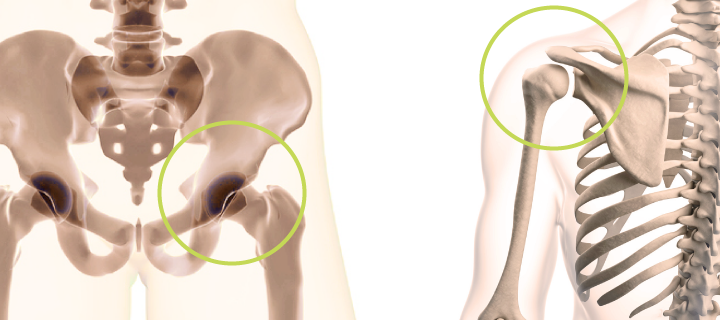

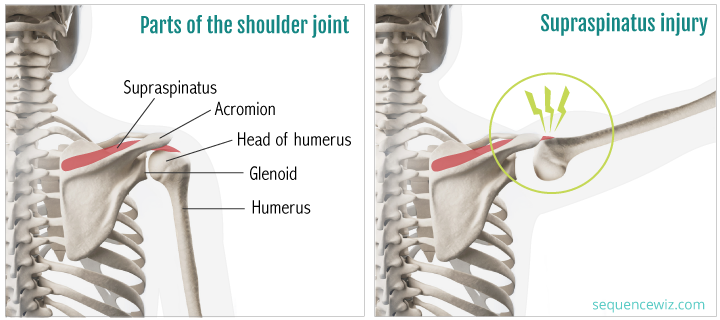

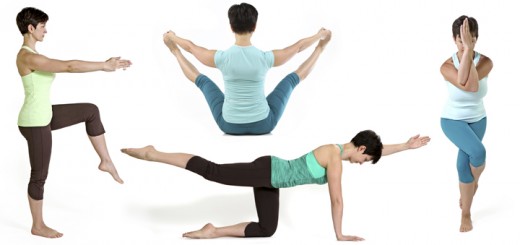
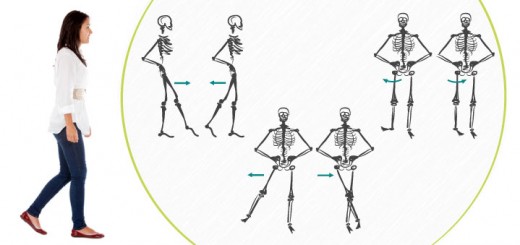
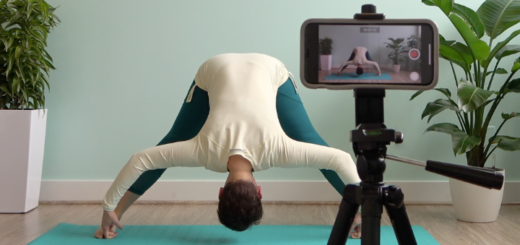
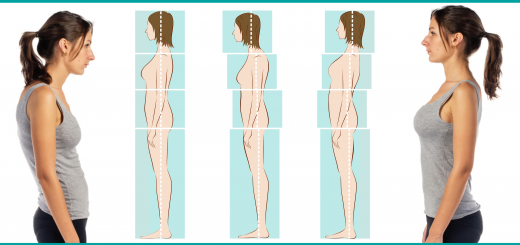















Thank you for this entry. I love your blog, but this article in particular really spoke to me, a repeat sufferer of shoulder injuries. Thanks for the enlightenment!
Thank you Kelly! I am happy to hear that you found it useful. Don’t give in to peer pressure when taking care of your shoulders! 🙂
Very well written and imperative information for teachers. Thank you!
Thank you Karen!
You mention “inherent” instability, wouldn’t instability result from improper use of our body whether sedentary or repetitive strain, and not have been a faulty way our human structure is designed? Kids hang and do handstands and all sorts of things without issue, and their shoulder functions properly until it learns a poor pattern. I agree that pushing yourself to the max after being seated all day is not the right use if your body, but isn’t there a healthy way to strengthen your joints and shouldn’t teachers of yoga or other fitness need to know how to teach people to work properly vs. just tying to push people to point of struggle or choreograph a flow that doesn’t have true instruction?
Hi Tasha, thank you for your comment! When I said “inherent instability”, I meant that some of us have looser joints then others from birth. Sometimes we refer to those people as double-jointed, sometimes we say that they have loose ligaments (which means that their joints won’t be held in place as securely, as somebody else’s). I do not mean that the design is faulty. And absolutely – there is a healthy responsible way to strengthen one’s upper body. Technically, you cannot “strengthen the joint”, since you cannot shorten the ligaments that hold it together, but you can certainly strengthen the muscles that support it. It does take time and careful planning though.
Terrific article! Thanks so much for the clear explanations and great visuals. I’m going to share this with my teacher-training buddies – thanks again!
Thanks Ben! Please spread the word!
I found the following step-by-step instructions for downward facing dog helpful: http://www.ekhartyoga.com/blog/arm-rotation-in-downward-facing-dog
It includes several images on how to roll your shoulders out while pronating the forearms.
This has to be the most brutally honest articles I have read with shoulder issues from practicing Yoga. I never had shoulder issues before Yoga but now suffer from 2/3 of the aliments listed in this article. It is incredibly easy to over strain the shoulders. Even simple static poses that require you to hold your upper body up add to the pile of strain put on the shoulders. The only answer I found to alleviate my issues was to reduce the amount of time I do yoga. I went from 12 hours a week down to 5 and now do other forms of exercise. Yoga can very easily become too much of a good thing if you’re not careful.
So sorry to hear about your shoulder issues. Another idea would be to check out other yoga traditions that limit the number of Sun Salutations and overall stress that it placed on the shoulders. There are other options, and I hope that your yoga practice will be something that you use to improve your health and wellness, rather then something that messes with them.
Your article is SPOT on! I practice hot vinyasa yoga pretty much daily and suddenly three weeks ago I got a horrible deep pain in my shoulder. It is made worse by bearing any kind of weight, whether it is downward dog (which I cannot do right now) or just the simple act of scrunching my shoulders while leaning over my computer. It did have a catching feeling but I think I was able to get a little bit of inflammation down a bit. I went to my doctor and he said it may be my AC joint or just a typical rotator cuff strain. Gave me a cortisone injection (which I hate), but it has helped with some of the pain and inflammation. I haven’t practice yoga for 3 weeks now. Wah! My question for you, how long did it take for your pain to go away enough that you were able to do down dog again, and do you have any suggested rehab to help get back to some sort of normalcy? Sounds like I need to mix up my workouts moving forward. Thanks for a great article!!
Hi Megan! So sorry to hear about your shoulder troubles. For now I would recommend that you avoid any weight-bearing activities until the inflammation goes down. You can investigate other types of yoga (if you are open to it) that don’t use San Salutation as a foundation for practice. It’s really hard to say how long it will take to heal, as it depends on the extent of damage, how fast your body heals in general and whether or not your shoulders keep getting irritated. Did your doc recommend a PT? If you want to integrate rehab with a yoga practice, you can look for a Certified Yoga Therapist in your area: http://www.viniyoga.com/learn-experience/viniyoga-teachers-and-yoga-therapists Hope this helps and wishing you a speedy recovery!
Hi Megan, after reading your article I get a strong feeling there is some myofascial dysfunction occurring that most Md’s, Pt’s are not able to assess or treat. Seek an Othopedic manual therapis that can assess properly and understands myofascial injuries.
Excellent article. Now I know what is happen to my arm clearly and need to stop yoga for a little while. I need to find another activity.
Thank you! Or you can find another yoga class that is not so Sun Salutation-heavy. Hope you recover quickly!
Thank you so much for this article. Very informative and great advice is given.
You are very welcome Linda! Glad you found it useful.
Olga Kabel,
Thank you for this great article. All your articles are very enlightening. One set of poses that really bother my shoulders are poses that include urdhva hastasana, Urdhva Baddhangullyasana, Urdhva Namaskarasana. I’ve started to keep my arms/hands shoulder-width in these poses. In poses with clasped hands behind back I use a belt to keep my arms shoulder-width.
Question: the upper arm position in Gomukhasana doesn’t seem to bother the bursa and supraspinatus. Is it just that I’m rotating my upper arms unconsciously?
Ed T.
Hi Ed, thank you for your comment! I am not sure why some of those poses feel more comfortable to you then others; sometimes it just depends on the individual’s joint and muscle shape. Interlacing the fingers up the top and turning them up is certainly challenging for many people (and more often for men, in my experience). Gomukasana your upper arm is EXTERNALLY rotated, which places it in a more favorable, less stressful position. Try this: extend your right arm out to the side and turn it so that the elbow is pointing down – this is external shoulder rotation. You would then raise your arm from here maintaining the external rotation and fold it into Gomukasana. If it feels better to keep the arms shoulder-distance apart in other poses, just do that! In my tradition it’s not the shape of the pose that matters, but the function of the pose; as long as you are getting the benefit, why does it matter whether or not your hands are touching at the top?!
Olga, Thank you. About a year ago I started to alternate between a day for Yoga and a day for Physical Therapy type exercises using T-Bands, elastic tubing, and light dumbbells. I even built a 12″ wide stall bar at home. I usually work on one or two muscles at a time and visualize the muscles I working on, which is just about the same as how I do Yoga. You blog posts have become indescribable for my practice.
What about headstands – Shirshanasa ?
I have an irritating ache in the left arm-shoulder area after an improper rise to a head stand (I tried to rise with straight legs, which caused a lot of pressure on the left arm), and I wonder what could exactly happened. It’s been a few months and the pain comes and goes..
Thank you,
Oded
Hi Oded! You can certainly get shoulder pain from improper rise to a headstand. In a headstand the weight distribution should be about 1/3 on your head, 1/3 on the right arm, 1/3 on the left arm. If that wasn’t the case and/or if your arms weren’t positioned well enough to support the weight, your left shoulder could have gotten hurt. Here the idea of bearing too much weight in an awkward position is similar to what I’ve described in the article.
Hey Thank for providing this information, I am glad I found this article.
I am already suffering from Tendinitis ad Bursitis before I started Yoga.
I am IT professional and sits and work all day long on computer and then i had this very bad shoulder pain which never gone even after sterioid injection and physiotherapy. I hear yoga can help me so I started Yoga almost 4 weeks ago(Doing yoga first time in my life) . it gives me on and off relief from pain and almost all classes has these sun salutation steps which as per your article can worsen my pain.
Please guide what can help me to protect my shoulder and reduce the pain with the help of Yoga.
Hi Shalini; sorry to hear about your troubles! You can certainly use yoga to help your situation, but for now I would recommend that you do not do any Sun Salutations. Instead try this short yoga sequence done in a chair; you can do it at your desk during your workday. At the end add a special move for your shoulders: Sit or stand with your arms hanging by your sides, fingers curled in and thumbs pointing forward(“hitchhiking” position). On the inhale lift the arms slightly turning the thumbs out and widening your chest, on the exhale return to the starting position. This move is super useful for the shoulders; I will post a video of it on my Instagram account(ok.yoga) in couple of days, come check it out if you like. For now it would be better for you to work with range of motion movements instead of asking your arms to bear any weight. I hope this helps!
So, then, how do you feel about Ashtanga Yoga practice?
Hi Kat, thank you for your question! My tradition is pretty clear on the subject – Pattabhi Joyce received his teaching from Sri Krishnamacharya when he was a teenager. It means that a practice like that is appropriate for young healthy adults whose bodies are still developing and who need to learn discipline. As we get older, our bodies and our needs change, so our yoga practice needs to evolve as well. That’s all. Every practitioner needs to decide for herself what she wants to get out of her yoga practice and proceed accordingly. My goal here is to help folks make an educated choice. Hope this makes sense!
Thanks olgakabel.
Your advise really helpfu for me.
I will wait for your post on instagram.
Your article is very insightful. I have a left shoulder degenerative small muscle tear rotator cuff injury. I have full range of motion in my left shoulder but experience a lot of soreness and sometimes stiffness. I have been practicing yoga for a bout 2 months because supposedly the discipline promotes healing. I had an inkling that yoga was not conducive to my shoulder healing but I thought it was in my head so I kept on pushing. After reading this article, I will definitely take a break from yoga.
Sorry to hear about your shoulder Walter. Yes, Sun salutation-based yoga practice is probably too much for you right now, but there are many other styles that don’t stress the shoulders as much. I hope you find a class that feels right.
I like the article, although as an 18 year orthopedic manual therapist/foundational movement therapy trainer. My biggest observation is that in the list of recommended advice there is no mention of specifically training the shoulder complex to be able to handle doing downward dogs or planks. What I have found through my Yoga patients is that Yoga itself doesn’t train the kinetic chains properly to achieve healthy stable shoulders.
Hi Mauro – I agree! Often students need a dedicated developmental program to strengthen and mobilize their shoulders. The focus of my post was mostly on raising awareness of the impact that “high-power” classes can have on the shoulders. Thank you for commenting!
Hi Olga, I praise you’re raising the Awareness. Paradigm shift of most importance! Look forward to receiving your future articles!! Greatly appreciate it !!
🙂
Hello Mauro,
Do you still work as a orthopedic manual therapist/foundational movement therapy trainer?
Online sessions?
Please let me know.
Thank you,
Lenore Post
Thank you for your article….I am an aerialist and former gymnast, shoulder issues sneak up on me constantly if I don’t maintain a regular pt schedule. Someone suggested I try yoga, & after several classes I commented how frustrated I was that my shoulders cannot handle all the downward dog poses. The teacher at that time, said it just comes with practice.
Your article finally makes everything come together for me. I feel I am someone who has good shoulder strength and body awareness, so knowing now that I don’t need to do 10 sun salutations leading to shoulder pain and that maybe only two is just as good. Thanks again!
Thank you for your comment Deidra! Indeed, there is no need for countless Sun Salutations to have an effective yoga practice, especially if you know that your shoulders are prone to crankiness. 🙂 We can still work on strengthening them, but in a slow mindful way.
Thanks for this, I actually stopped going to a Ashtanga (very physical) class because it strained my shoulders too much (and i am not unfit). So here you go. I follow a more relaxed Yoga class which remains physical but does not insist on this continuous (flow) Downward dog – Chaturanga – Upward dog combo !
Namaste
Hi Richard! It’s great to hear that you found the style that works for you!
This is very valid. I really like the points made here and the advice given, especially for ‘power’ type classes. I do have something to add to this too. I am doing a Post Grad with Ihana yoga and they have done a blog on the shoulder alignment of side plank which is very relevant to this. The side plank alignment in this article definitely would aggravate the shoulders but have a look at this article because it assists with stabilisation much more effectively where side plank is concerned.
https://www.youtube.com/watch?v=hc7rpMon7Jc
There is also this one on the common cue of ‘pull the shoulders down’ which feeds into this : http://ihanayoga.com.au/myth-busting-the-common-cue-pull-the-shoulders-down/
Hope this helps as much as your posts do 🙂
Hello and thank you very much for your article. I’ve been in pain for more than 3 weeks not knowing what to do or what was it specifically, I had X-rays done at doctors office but did not revealed any injuries and the pain sometimes is unbearable. You’ve mentioned in previous responses that we can look into other styles, but which styles would give us similar benefits? can you mention a few?
Hi Lillian! So sorry to hear about your pain! I would recommend viniyoga if you want to try a more therapeutic approach. Where do you live? You can follow this link to find a qualifies viniyoga teacher or therapist in your area. Just select your country and then state and see who is teaching where. Hope this helps!
This article is very informative and we should keep reading often and put the advice in practice daily for all human beings for our own good health, including Physical health, Mental health and spiritual health in that order to make this rare human life, worth living to fulfill the mission of our life namely not to born again on this earth in any form to mingle with Brahman from where we all came in the first instance. We need to pass on this most valuable web site to all our family and friends. We are all most greatful for the people who are responsible to this web site. Please keep up the good work and try to present video clips on all the exercises to the web site to watch and practice in our own Homes which will be a wonderful service.
Can you write a post of alternative transitions we could do in a vinyasa flow class if the teacher is doing a lot of down dogs and chaturangas? I’m in fairly good shape so ideally there would be a physical challenge that is just not as shoulder-intensive… I’m looking for another option besides doing the knee chaturangas or just skipping the transitions. Thank you!
First of all, thank you so much Olga for sharing your fantastic knowledge! I’m a subscriber and have been reading so many of your articles and checked out the videos. I’m looking for the same answer as Christina – what alternative transitions do you recommend? I’m yoga teacher graduated half a year ago and I hold Vinyasa Flow classes… Plus most of the classes I go to myself includes Sun Salutations and vinyasas. I have already realised that doing loads of vinyasas is both boring and too hard for my students shoulders. So I do limit the vinyasas, the first 2-3 rounds from high plank drop the knees to table top – lower down with elbows close to body and low cobra then DD. Is this a good idea do you think? I read somewhere that knee-chest-chin is not such a great modification? Then during class I add only a few vinyasas where students have the option of course to continue with the easier version or doing full chaturanga, upward dog and downward dog. It does feel nice to add a vinyasa now and then between poses to lengthen and flow and transition smootly into the next move.
One more question please 🙂 not sure if you can help, but personally I struggle too with correct chaturanga; to roll over the toes and end up with shoulders over the wrists in updog. My shoulders end up too far over the wrists as I have long arms and short legs, not a great combo! One way to improve alignment has been to turn the feet one by one – but as an assymetrical movement is not good in the long run? Thank you again!
Very well written article. I had impingement caused by inflammation (a calcification the size of a chickpea within the supraspinatus). This caused increasing pain until finally a wonderful orthopaedic surgeon ‘fixed’ me. After 3 wonderful pain free months I enrolled in a yoga class which immediately brought on intense pain again.I’d love to find a teacher who takes people’s limitations into account. Pity you’re so far away!
Thank you! I have injured my shoulder for the first time at yoga yesterday, and it is exactly as you describe impingement. In fact, I recall the exact moment in which I “dropped” and my shoulder ached slightly… only to get worse afterwards… I was wondering what do you recommend to help with recovery? Cheers!
Hi Elena, sorry to hear that! I would recommend that you leave it alone for now, and once it feels a little better ( may be in a few days or a week) you can try this practice: http://sequencewiz.org/2016/03/09/liberate-your-shoulders/ I hope this helps!
Thank you for the prompt and very helpful reply! I am glad I have found your blog!
Thank you for your article. I have been on an intense power yoga plan for 6 months and last weekend noted a shoulder twinge after a class that really focused on arms and core. That has now turned into pain, loud cracking and limited mobility although it felt better during class on Thursday (probably the warm up and stretching helped). I am somewhat panicked because I don’t want to quit what I have started and what I enjoy so much. I am going to try class modifications and then if it doesn’t work, total rest. Unfortunately, most of the recommendations for impingement syndrome do seem to include stretching. We live in a pretty rural area (aka limited yoga options)most other styles/approaches to yoga are not convenient. I really appreciate your advice.
I’m doing climbing (with pull-ups 5 days per week to keep me strong) and added ashtanga yoga this January. First shoulder injury came in March, didn’t heal properly and now I’m off ANY training again, except for light stretching, because the shoulder started acting up again. I like powerful moves, but it seems that climbing combined with sun salutations, vinyasas (especially jump through) and learning handstand is a bit too much. So now I’m trying out different sun salutation modifications that don’t involve putting weight on your hands, although it still feels like cheating.
Oh God. So. Much. This!
I was doing a pretty strenuous home yoga routine a few years ago, and my shoulders were simply KILLING me. A particular moment that sticks out in my mind is when my partner and I went to a restaurant. When they brought the food to us, I very nearly burst into hysterical tears. My partner asked me what was wrong and I cried “I’m hungry!” and he sort of looked askance at me. “…so…eat…?” “I can’t”, I bawled, “I can’t lift my arms!”
I ended up modifying my practice, and doing a lot of those arm support poses in a modified position, but honestly, as a beginner, I shouldn’t have had to come up with that on my own.
Hi,
Thank you for taking the time to put together this comprehensive article. Also thank you guys for the lovely blogs. You have put Yoga and its effects into perspective. This really makes perfect sense,,like any exercise,,it needs to be approached respectfully and with careful instruction. Yoga,I am learning,, is not a “soft option” or an alternative to other mainstream exercise…I have only been developing my yoga practise for 18 months,,and during that time experienced different styles of teaching and egos! I do have a teacher background,,,and through years of experience I have found that its so important to assess and evaluate each student’s ability, knowledge, skill and progress. Yoga surely should leave the student feeling good about themselves? This I have found has not always been the case, due to a lack of vigilance and understanding of the teacher. Thank you once again for your article and comments. Georgie
I’d been doing yoga for about 3 years, when we had a new yoga teacher. I never did find yoga easy, but with the new teacher I found it even harder and I seemed to be holding the pose for longer. On one occasion, we did side plank, along with some other similar poses; I did think at the time that there was a lot of pressure on my shoulders, but didn’t realise the damage I was doing. A few days later I found I was having a lot of problems with my right shoulder/upper arm and am still having problems 3 months on. It doesn’t hurt all the time: only in certain positions or if I lie awkwardly at night. It’s fine at work, when my arm is resting on the desk, but if I lift it up a little and hold it there, it hurts. I don’t know how long my shoulder/arm will take to repair, but it has rather put me off yoga. I did attempt to go to the class after my injury, but found it impossible to do one-armed! I haven’t been at all since before Christmas.
Hi there, Unfortunately this article makes all too much sense at the moment. I was in the habit of following a video on YouTube of ten sun salutations done in succession but have recently been experiencing acute shoulder joint pain- my shoulder was always a bit dodgy but the pain at the moment is on a different level altogether. I was just wondering if there are any poses that might help to relieve the damage I’ve done with the sun salutation reps?
I have been doing yoga off and on for nearly 20 years now. For the past several years, I started getting random intense pain in my shoulder blade, from the back that radiates straight through my body to the front, just under my collarbone, and sometimes it is so bad it nearly goes up and down my body too. It feels like my shoulder is going to fall off, that’s how bad it hurts sometimes. And then just as suddenly it can go away after a few days, more or less. I couldn’t figure out what was causing it since I wasn’t really doing anything new. But during the pandemic I stopped going to yoga – and the pain stopped. I just did yoga at home again today, with downward dog and chatarunga a few times, and now my shoulder hurts again. There’s very little information out there about this, so I am really happy to have come across your article, it makes me feel validated! I went to an orthopedic Dr before, an xray of my shoulder showed nothing, and they sent me to a PT. They said my shoulder muscles are weak on the side that hurts and I need to strengthen them with PT exercises. I was going for a couple of months but didn’t seem to notice any difference, or sometimes it would just prolong the pain maybe. I’m going to avoid downward dog and shoulder weight bearing poses from now on, it obviously really messed something up. I’m annoyed I never heard of this before and nobody else is talking about it!